
- Usage in publication:
-
- Hiwassee slate*
- Modifications:
-
- Named
- Dominant lithology:
-
- Slate
- AAPG geologic province:
-
- Appalachian basin
Summary:
Name Hiwassee slate introduced in this report for exposures of bluish-gray or bluish-black slate along the Hiwassee River in northeastern TN. Unit extends to northern GA and western NC. Slate weathers to greenish, yellowish gray, and yellow. The slates are interstratified at intervals with lenticular layers of blue or dove-colored limestone. North and northeast of Hot Springs many of the slate beds are somewhat sandy, a little coarse-grained, and marked with light-gray siliceous bands of sedimentary origin. On the other side of French Broad River, the rocks are finer-grained and more uniform. In many northwestern outcrops the slaty character is less pronounced and some layers are almost unaltered shales. A noticeable constituent in some beds is mica in fine scales--an original deposit and not a secondary growth. Bulk of material composing the slates is argillaceous. To this is added here and there the micaceous and sandy material. West of Allen Stand the deposits of sand were enough to make distinct layers 8 to 10 ft thick, which locally developed into fine conglomerates. In vicinity of Pigeon River and Crabtree Bald, the rocks are so metamorphosed that they consist almost entirely of schists of several varieties, with interbedded layers of graywacke. Most of the schists are dark gray or black, varied here and there with lighter gray bands. Thickness 700 to 1,500 ft. Overlies Snowbird formation and underlies Cochran conglomerate. Age is Early Cambrian.
Source: GNU records (USGS DDS-6; Reston GNULEX).
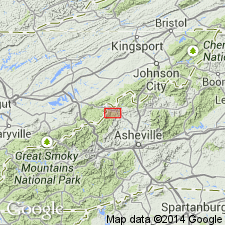
- Usage in publication:
-
- Hiwassee slate
- Modifications:
-
- Not used
- AAPG geologic province:
-
- Piedmont-Blue Ridge province
Summary:
In Hot Springs area, NC, Sandsuck shale is substituted for slate mapped as Hiwassee by A. Keith.
Source: GNU records (USGS DDS-6; Reston GNULEX).
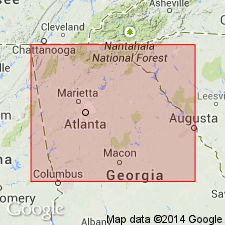
- Usage in publication:
-
- Hiawassee slate
- Modifications:
-
- Areal extent
- Revised
- AAPG geologic province:
-
- Piedmont-Blue Ridge province
Summary:
Hiawassee [Hiwassee] slate assigned to Talladega series in GA. Age is Precambrian.
Source: GNU records (USGS DDS-6; Reston GNULEX).
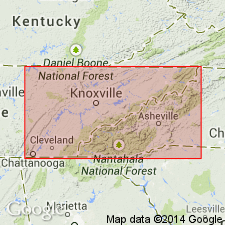
- Usage in publication:
-
- Hiwassee slate
- Modifications:
-
- Overview
- AAPG geologic province:
-
- Appalachian basin
Summary:
Sandsuck shale mapped northeast of Pigeon River corresponds roughly to what Keith mapped as Hiwassee slate in same area. In its type area along Hiwassee River, Hiwassee slate corresponds roughly to whole fine-grained part of Ocoee series, and its correlation with units farther northeast is uncertain.
Source: GNU records (USGS DDS-6; Reston GNULEX).
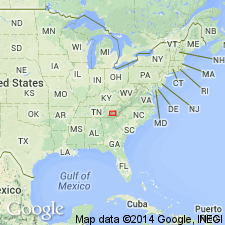
- Usage in publication:
-
- Hiwassee slate†
- Modifications:
-
- Abandoned
- AAPG geologic province:
-
- Appalachian basin
- Piedmont-Blue Ridge province
Summary:
Walden Creek group (new) corresponds approximately to Wilhite slate, Citico conglomerate, and Pigeon slate, as mapped by Keith (1895) in Knoxville quad, and also to the more inclusive Hiwassee slate of his later terminology. Name Hiwassee has been used so confusingly that it is properly abandoned.
Source: GNU records (USGS DDS-6; Reston GNULEX).
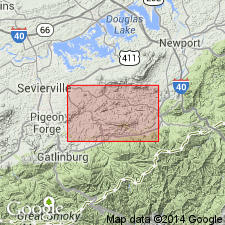
- Usage in publication:
-
- Hiwassee slate
- Modifications:
-
- Not used
- AAPG geologic province:
-
- Appalachian basin
Summary:
In his unpublished report on Mount Guyot quad, A. Keith applied the names Hiwassee slate to fine-grained rocks and Citico conglomerate to coarse-grained rocks for what is here called Walden Creek group; these names have no stratigraphic significance in this area, were derived from geographic features many miles to the southwest, and are not used in this report.
Source: GNU records (USGS DDS-6; Reston GNULEX).
For more information, please contact Nancy Stamm, Geologic Names Committee Secretary.
Asterisk (*) indicates published by U.S. Geological Survey authors.
"No current usage" (†) implies that a name has been abandoned or has fallen into disuse. Former usage and, if known, replacement name given in parentheses ( ).
Slash (/) indicates name conflicts with nomenclatural guidelines (CSN, 1933; ACSN, 1961, 1970; NACSN, 1983, 2005, 2021). May be explained within brackets ([ ]).

